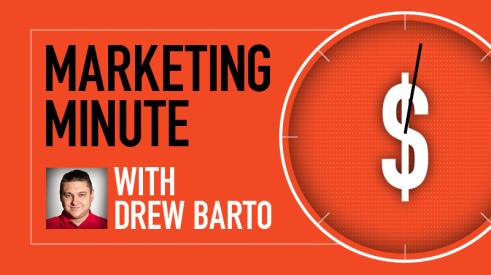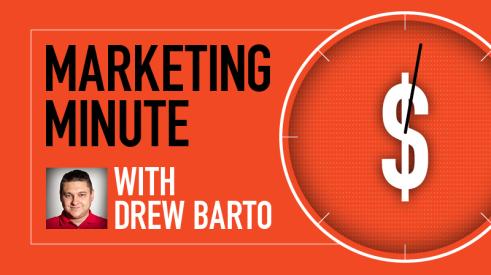FIRST OF A TWO-PART SERIES
The remodeling market has exploded over the past 10 years, and that boom in business has put many of the best and most professional firms in position to take advantage by increasing their share of the local market.
To do this, however, two key areas of the business must undergo structural, philosophical and procedural change to attract those clients that mere referrals and repeats cannot: sales and marketing.
In this first installment of Professional Remodeler's two-part series on sales and marketing strategies for increasing local market share, we focus on strengthening your sales strategies. Here are five tactics many remodelers are using to get better at turning new prospects into clients for life.
1. Build an Idea Center
When Dan Bawden, CGR, CAPS, GMB, drew up the 2006 business plan for design/build firm Legal Eagle Contractors in Houston, it called for an increase in revenue from $1.2 million to $1.5 million. It also was based on taking fewer jobs, which meant he needed to attract bigger jobs than in the past.
Bawden's strategy was to buy and renovate a 2,100- square-foot residence into an idea center that would house his offices and serve as a showcase of the company's work. Dan, the company's president, and his wife, Konne, vice president and CFO, bought the property for $285,000 ($80,000 below market value; it had been vacant for more than a year). They lease the home to Legal Eagle, which they own, so the firm covers all the costs, including the mortgage payment, maintenance, utilities and taxes. Because the upscale neighborhood has homes in the $600,000 price range, Bawden anticipates being able to sell the property for a profit when that time comes.
 |
| Dan Bawden's strategy for getting larger desing/build jobs for Legal Eagle Contractors included building an idea center that doubles as the firm's offices. Photo by Charles Edwards |
"The core idea is to be able to show clients in a real house — not a strip mall, not a separate commercial building, but a real house — what they can do in their own home," says Bawden.
Bawden, who handles the company's sales and estimating, used to do his sales presentations at the client's home, bringing along a book of project pictures and showing them his Web site on the customer's home computer.
"I was limited to showing them pictures and discussing ideas from other locations," says Bawden. "This has given me a much more professional presence that distinguishes me from my competition. It's an ideal situation to be able to get the husband and wife in here to walk through and take a tour first before I go to their home."
Bawden installed a plasma television connected to a laptop where he can create and/or modify plans on Chief Architect while the client watches on the big screen.
"It's immediate gratification, which baby boomers love," says Bawden. "And the plans take shape much more quickly because I can do them while they're sitting there. An architect might take three weeks to get back to them with plans. They start pointing and getting all excited: 'See that's what I told you it was gonna look like, honey.'"
The renovation cost about $150,000 and took four months to complete. Bawden solicited manufacturers and suppliers for donated and discounted products to help defray about $100,000 in additional materials costs.
 |
| Legal Eagle Contractor's idea center includes a plasma television screen where Bawden can use a laptop to manipulate project plans for his customers while they watch. Photo by Bob Jackson |
Bawden held a weeklong grand opening from 4–7 p.m. daily that attracted 150 people. He promoted the event in several ways: putting a large "Coming Soon: Legal Eagle Contractor's Remodeling" banner on the main street side of the house 60 days before the opening; mentioning the event to all clients they met with during the construction; mailing letters to their top 200 clients and e-mailing invitations to 3,000 clients and prospects from their database.
Bawden also scheduled a ribbon-cutting event a week later with the chamber of commerce that attracted 25 more people and produced a published photograph that helped market the company.
"One of the hardest things to do is to find ways to separate yourself from your competition," says Bawden. "And having a place like this is part of what I use in my toolbox to set us apart. So once I get them here, I show them cool ideas they won't see anywhere else, and it's helped me separate myself from everybody else."
2. Charge an Estimate Fee
If window shoppers and tire kickers take up too much of your sales team's time, consider charging a non-refundable fee for estimates.
Damon Rumsch, CAPS, CGR, president of Coral Construction in Charlotte, N.C., has been charging $1,000 for estimates since early in the company's existence. The strategy has all but eliminated his wasted time chasing dead-end leads. Rumsch has just one employee other than himself and sees the fee as a major reason he has been able to rapidly increase his sales from $1 million to $4 million per year in installed sales without adding a single sales person. Rumsch remains the company's sole salesman.
Coral does large, high end renovation and the occasional new home with an average job size of about $250,000. His estimates are detailed and time-consuming, and he uses flat fee contracts with a markup of 26 percent.
"Because a lot of times my prices were coming in higher than my competition and I wasn't getting very many of those jobs, and because I really don't like doing estimates, and because we're small, I decided to go ahead and charge $1,000," says Rumsch. "That takes care of the time that's involved in doing a thorough estimate, but it also gets rid of the people that are just shopping."
Rumsch tells all his prospects about the fee over the phone before meeting with them. He explains that it's non-refundable, but that it will be applied to the cost of the job if they sign a contract to do the project with him.
"I want to go into it with the understanding that my time is valuable and know that they're willing to pay for that time to get the numbers together and are seriously interested in working with us," says Rumsch. "I just remember when we first started, Walt Stoeppelwerth was saying that you needed to expect to only get about 10 percent of the jobs you looked at. And that just seemed outrageous to me. There's just so much time involved in estimating, it isn't worth my time."
Rumsch's advice to other remodelers who operate with a small sales force in a competitive marketplace and doing quality, high-end work?
"I think a lot of remodelers are really scared to do it, but it's the only way I could stay in business is to do it the way I do it," says Rumsch. "It just eliminates all those people you're going to lose to lower-priced contractors anyway."
3. Use Audio-Visual Presentations
College City Remodeling in Lakeville, Minn., has undergone such tremendous growth in the last three years that general manager Bjorn Freudenthal, CAPS, felt the company needed to have greater control over the company's sales message. College City has eight full-time employees, but that includes three sales people where there previously was just one.
Freudenthal created an audio-visual slideshow in Microsoft PowerPoint, that all three sales people now use to deliver a consistent message on all client calls. College City started using the presentation in 2004 and promptly doubled its sales from $1.1 million to $2.2 million.
"We wanted to make sure that when we are in the marketplace we are delivering a consistent message," says Freudenthal. "We're not by any means a huge organization. We've got three people walking around and talking about who we are and what we do. So in an effort to make sure that we get to a platform where we're speaking with the same tongue, that's what we did."
The presentation includes the company's history, the type and volume of jobs it specializes in, certifications achieved on staff, involvement in industry associations, cost of typical projects versus value to the homeowner and awards the company has won.
The sales person uses a laptop for the presentation, but they also have a hard copy for the prospect to keep after the sales person has left.
College City also has produced a two-minute video to show clients projects the company featured in the Builders Association of the Twin Cities' Parade of Homes.
"It's a very short, two-minute deal that shows before-and-after pictures, what the objectives were, how we emerged victorious over the challenges with the solutions and how we got the end result," says Freudenthal. "That's something that's helped us tremendously."
4. Pay for Performance
Another key to the College City sales equation has been a pay-for-performance incentive plan for the sales team. College City's sales staff receive a base salary plus commission based on three areas of performance: sales volume, profit margin and customer satisfaction.
"If you agree that those three things are important, you build a PFP that's going to drive all of those behaviors and kind of put it on auto pilot because everybody gears their actions accordingly," says Freudenthal. "We've been very successful in implementing that, just for the simple reason that it's very hard to build a system that would take all the different things into consideration. You could build one on volume and get hurt on the profitability, for instance."
Freudenthal emphasizes the importance of having a competitive base salary, however, because the company relies on the sales person to be a consistent representative to the client throughout the life of the project.
"We have a very competitive base salary, just to acknowledge the fact that our sales people are not just sales people," says Freudenthal. "They're also the go-to person, the main responsible person throughout the project. So they have a vested interest because they also need a referral at the end of the day and want to get the next job and the next job."
Donna Bade Shirey, CGR, CAPS, president of Shirey Contracting, in Issaquah, Wash., instituted a similar pay structure for its sales team this year and has seen immediate growth in its sales volume.
After selling $135,000 in February and $100,000 in March, the company sold $469,000 in April and $570,000 in May. April was the first month they used the commission-based pay.
Shirey's three sales people, which includes herself, receive a salary plus commission based on gross profit.
"With the commission system, we are very motivated to sell," says Shirey. "It has revolutionized things around here. It's incredible."
5. Provide Consistent Sales Training
In 1997, Shirey attended a Sandler Sales Institute seminar set up by her local Remodelors Council. She immediately started incorporating some of what she learned in the seminar into her strategic thinking, but it wasn't until this year that Shirey signed up for a two-year training program with Sandler, which she estimates will cost the company roughly $75,000 over two years.
The Sandler agreement includes weekly two-and-a-half hour phone conferences with the Shirey team, plus an in-person conference with the Sandler representative in Shirey's office two days a month.
"It's a huge commitment, not only monetarily but time-wise," says Shirey. "But it teaches you how to screen clients, how to make sure you're a fit and to always do an upfront contract. And it has made such a tremendous difference in our sales. We have everyone in the office in on this weekly sales call, because we feel everyone in the company is a sales-person, starting with the gal who answers the phone sitting at the front desk. She knows how we want to approach clients and how to screen them."
Shirey doesn't just include the office and sales personnel in the monthly in-person conference; she incorporates the field staff for a half-day of training as well.
"We're teaching them all about gross profit margin and how the work they do in the field affects the bottom line of the company," says Shirey. "So we're basically doing this open-book teaching to our staff. To me it's a little bit revolutionary to let the guys in the field know this much information about a company, but we are a company that communicates."
That open communication and training has paid off on the bottom line in a big way for the firm.
"Recently we have actually turned down a whole bunch of business, which really is hard for me," says Shirey. "But sometimes there's a good reason to turn down business, and we're not afraid of that."
College City also has begun to emphasize regular sales training. The approach is more casual than Shirey's, but no less effective in the results it brings.
"We just have the three salespeople come together and get an understanding of how each of them execute the sales presentation differently," says Freudenthal. "We talk about the calls we've been on and develop some new ways or new angles or new words to put in to how you talk about each and every slide and how you talk about a different phase in our process.
"We are not talking about some high-profile sales trainer who comes in. We just have three guys humbly go to work and come back and say, 'Here's how I do my deal.' And we look at how they differ; we work with them according to each of their styles. We've identified that we have an owl, we have a tiger and we have a lamb within our sales force. So what it boils down to is to put the presentation in a form for that particular person to go out and execute."
Freudenthal also distributes the leads to the individual sales people based on their sales style and personality type to give them the best chance to communicate effectively with different client types.
"Typically about 95 percent of the leads come through me, and we talk about it openly as to who should go where," says Freudenthal. "In the qualifying process, which is done over the phone, I pick out who should go meet this person. Do we do it 100 percent right every time? No. But what we try to do is at least identify that our different sales people align better with certain types of prospects. We do that on a daily basis."
Five ways to increase your market share -- you can start today
Add new comment
Related Stories
How to Get More Leads with a Stronger Remodeling Brand
Discover how to build a strong brand for your construction company, and learn key strategies to differentiate and attract better leads
Building A Small Projects Division from the Ground Up
Through hard work and careful strategy, Harth Home Services has seen big growth
Helping Remodelers 'Get Their House In Order'
From remodeler to NARI executive to industry consultant, Diane Welhouse uses her expertise to help business owners
Finding Success Online and on the Jobsite
The Molitors started with humble blog beginnings, and now the couple runs an unlikely two-folded business for social media marketing and design-build construction
How Much Are Window and Roofing Contractors Spending on Marketing?
Director of Home Improvement Drew Barto reveals the percentage of revenue replacement window, door, and roofing contractors of various sizes are spending on marketing in 2023
4 Things for Remodelers to Understand About Google Analytics 4
The new era of Google Analytics is here, and it's set to help you make better marketing decisions through in-depth metrics
The Empty Chair: Customer Experience Will Differentiate Your Business
With all signs pointing to a softer market, how can remodelers remain strong and different from the rest? Pro Remodeler's Director of Content Erika Mosse shares real examples.
Marketing Minute: How to Overcome a Drop in Demand
Director of Home Improvement Drew Barto shares tips on how to survive and thrive in periods of lower demand for your products or services
Do You Have a Healthy Marketing Mindset?
Use your marketing calories wisely and form healthy habits today to keep your business in shape












